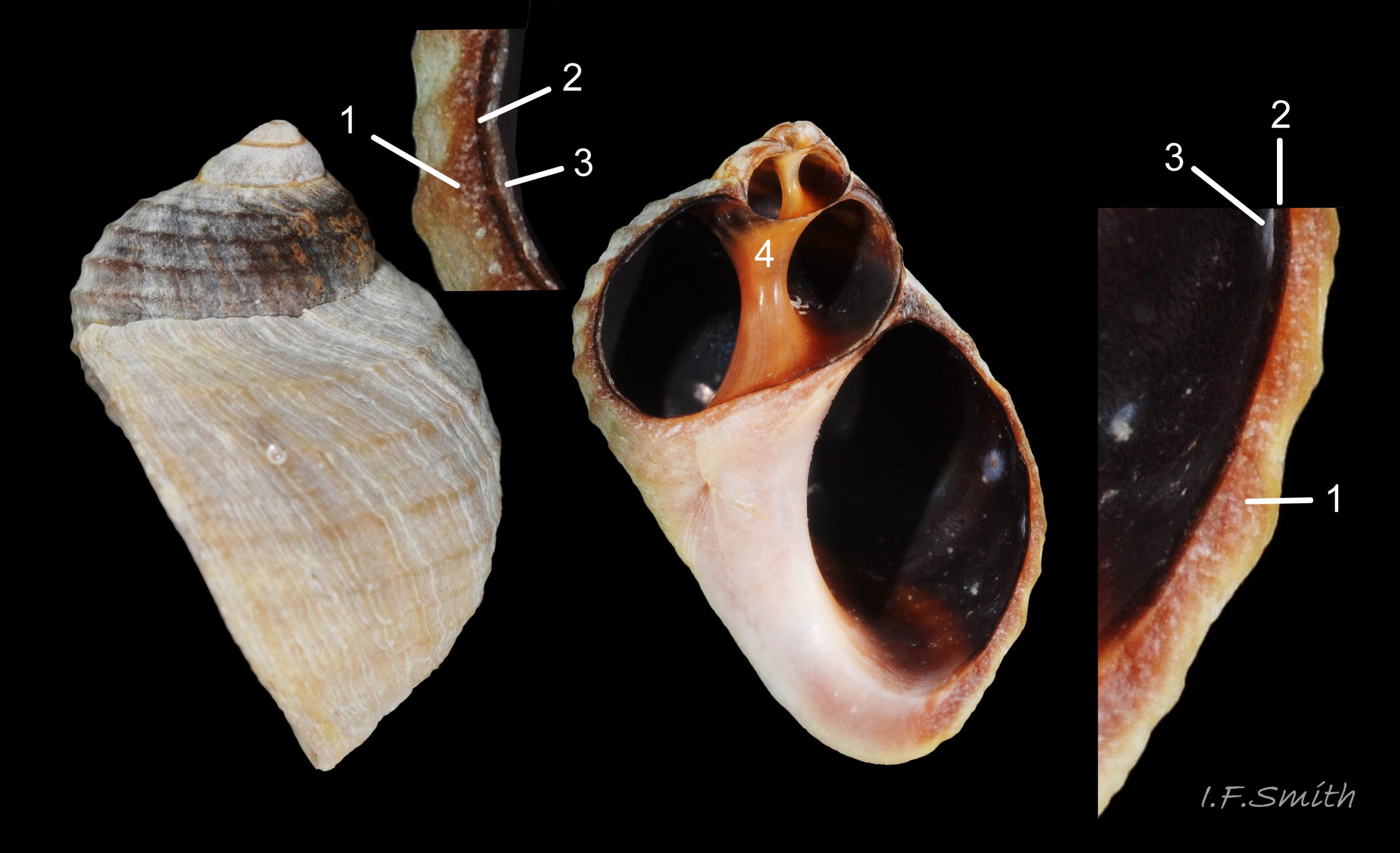PROVISIONAL text. I have found great variation and contradiction in paper & online sources. Your comments would be appreciated.
In particular, last 3 lines about layer 3 are based on my examination of the disposition of the layers and on reasoning unsupported by any source that I can find. Please say if you see any flaws in my interpretation (also of layer 2).
The Alden reference at the end doesn’t appear especially authoritative, do you know of a better one that supports or disagrees with what he says about oceans?
A troubling thought is the glaze deposited on the body whorl to form the parietal lip of this and many other gastropods. It can only be deposited by the mantle skirt when the animal is not retracted. Is it another pre-2 layer that gets covered by layer 2 as it advances??
TEXT:
The following structure of layers is common to all Littorina species of Europe’s Atlantic coast. Other taxa vary.
Periostracum on outer surface is thin and indiscernible, or eroded away.
1: outer layer 1 is of calcite morph of calcium carbonate with irregular-prismatic structure. Whitish and rufous on this specimen. Deposited only by mantle-edge on aperture-margin in micro-growth bands corresponding to tidal cycles. Layer is thin on spire whorls formed when animal small, increasing in thickness on later whorls with growth of animal.
2: dark brown layer 2 is of aragonite morph of calcium carbonate with crossed-lamellar structure. Primary lamellae arranged perpendicular to aperture margin. Deposited by visceral mass over entire inner surface of layer 1, except for wide band within aperture rim where mantle skirt, not viscera, in contact with shell when animal extended, and uncovered when animal retracted. Layer 2 is fairly uniform in thickness throughout the shell.
3: white (or pale) layer 3 is of aragonite with crossed-lamellar structure. Thickest in older, early whorls, acting as spire-filler; compensates there for thinness of calcite layer 1.
Layer 3 dwindles to imperceptible in larger whorls. It, like layer 2, is deposited by surface of viscera. Because of its disposition, it seems that layer 3 is deposited by the posterior of the visceral mass, moving over layer 2 (that was deposited by the anterior viscera) as the animal grows.
4: columella made of brown layer 2 thickly coated with white translucent layer 3.
Properties of aragonite and calcite.
Shell layers are of calcium carbonate in a fenestrated matrix of proteinaceous conchiolin which affects their properties. Data are averages for the pure minerals.
Hardness on Moh scale: aragonite, 3.5 – 4, harder than calcite, 3.
Specific gravity: aragonite, 2.95, denser than calcite, 2.71.
Solubility: both have retrograde solubility i.e. more soluble in cold sea water than in warm sea water. Calcite is 35% less soluble than aragonite.
Comment
As aragonite is denser and harder, it should resist crushing by predators and accident better than calcite. Over geological time the oceans have fluctuated between aragonite and calcite rich water, each favouring species that use what is most easily available. For the last 40 million years the oceans have been aragonite rich ( Alden, 2014). For these reasons one might expect aragonite to be the commoner mineral morph in seashells. However, D. Reid (1996) states,
“In most gastropod shells calcium carbonate is present in the mineral polymorph aragonite, whereas calcite is of much more restricted occurrence (Bøggild, 1930). In two species of Littorina [sub-tropical] – – – the shell is entirely aragonitic, whereas in all remaining species there is an outer layer of calcite. – – – Taylor and Reid (1990) pointed out that, in the Littorinidae as a whole [includes other genera], groups with calcitic shells are found only in temperate and higher latitudes. They suggested that intertidal animals are particularly exposed to the danger of shell dissolution, because of accumulation of carbon dioxide during the night in inshore seawater. Dissolution of calcium carbonate is most likely to occur in cold water, in which it is more soluble. Since calcite is less soluble than aragonite, they argued that shells with an outer calcite layer should be more resistant to dissolution.”
Alden, A. Calcite v aragonite
geology.about.com/od/minerals/fl/calcite-vs-aragonite.htm
No full account yet of this species.
marinvert.senckenberg.science/image-browse/7215763361…

